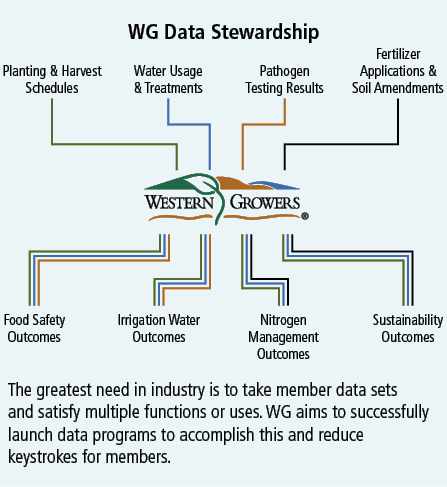By Marlene Hanken, Data Analyst
Welcome to the Data Corner, a place where this resident data nerd addresses some of the most common data issues and data-related topics facing the agriculture industry today.
This column’s topic is how data can inform multiple uses or outcomes. Another way to think about it: “Capture once, use multiple times,” which refers to the ability to capture data one time with many uses in mind and in a variety of ways. Much like a single lot of fresh produce can be sent out into commerce and feed a variety of landing-places, so too can the data you capture related to your crops feed and drive multiple end uses. Analogously, those raw agriculture crops can be converted into fresh-cut products much like data can be processed and converted in visuals and other analytical tools for insights beyond their initial intended use.
Let’s look at a specific example: water usage and treatment data. These data may include information such as irrigation quantity, water type and water sources, offering a variety of uses besides satisfying internal audits. These data can be used to inform food safety practices, irrigation water management, nutrient management and sustainability outcomes (See illustration below.)
Other data points related to water applications, such as water treatment types and water quantity/quality, are instrumental in the assessment of irrigation practice effectiveness. For example, creating a graph visualizing the quantity of water treatment applied and comparing with the application date may be able to show potential treatment efficiency trends for a particular crop during any time of year. This information can help anticipate when to increase or decrease treatment quantities and provide guidance in planning resources (Example illustration at right.)
Utilization of water quantity (number of gallons/acre-feet) applied to crops is an ability for assessing nitrogen management outcomes. For instance, information such as the amount of water and nitrogen applied (along with other nitrogen applied and/or removed factors) can be used to calculate nitrogen loss through surface runoff. Poor water distribution and uniformity, including over irrigation, may lead to wasting nitrogen, displacing nitrogen away from crops where it’s needed and into possibly harmful and non-targeted areas. This is one way improper irrigation management may result in inadequate nitrogen management outcomes. While there are many factors involved in a comprehensive nitrogen management strategy, water usage data certainly plays a critical role in this arena.
Water usage and treatment data, coupled with planting/harvesting information and pathogen testing, can also inform food safety outcomes. This has long been a topic of research and study as many in the agriculture industry strive to understand the effects of irrigation practices in fresh produce safety.
To this end, the Western Growers Science team is pursuing data projects that utilize this concept of “record once, use multiple times” to satisfy multiple endpoints and increase functionality in data which our members are already collecting. The goal is simple—get more done with less work. Our data projects strive to reduce keystrokes while allowing members to continue devoting resources to where they matter most…on growing the best medicine in the world.
Do you have a data topic you want us to address in the next issue of The Data Corner? Email us at [email protected] today.

